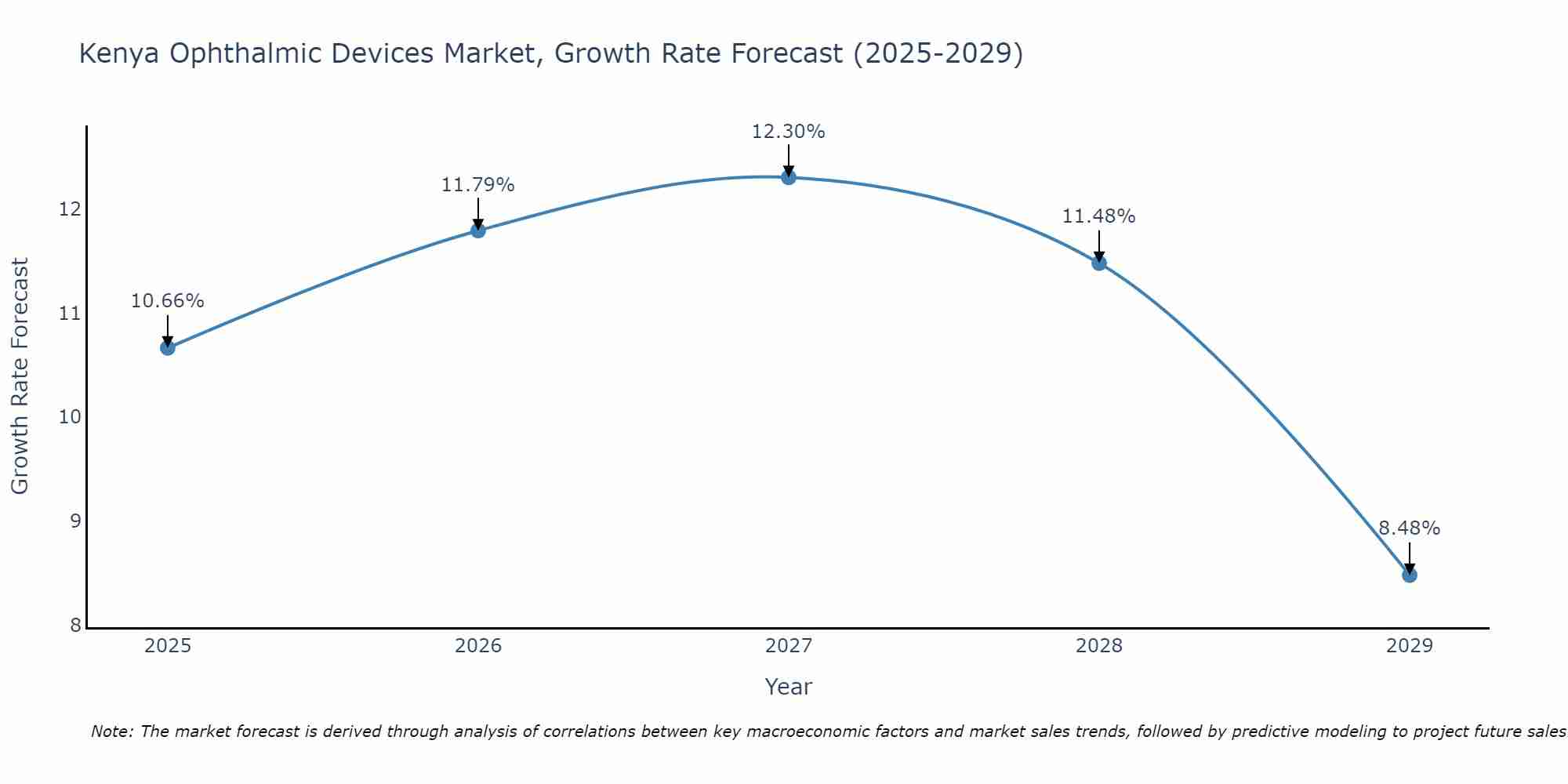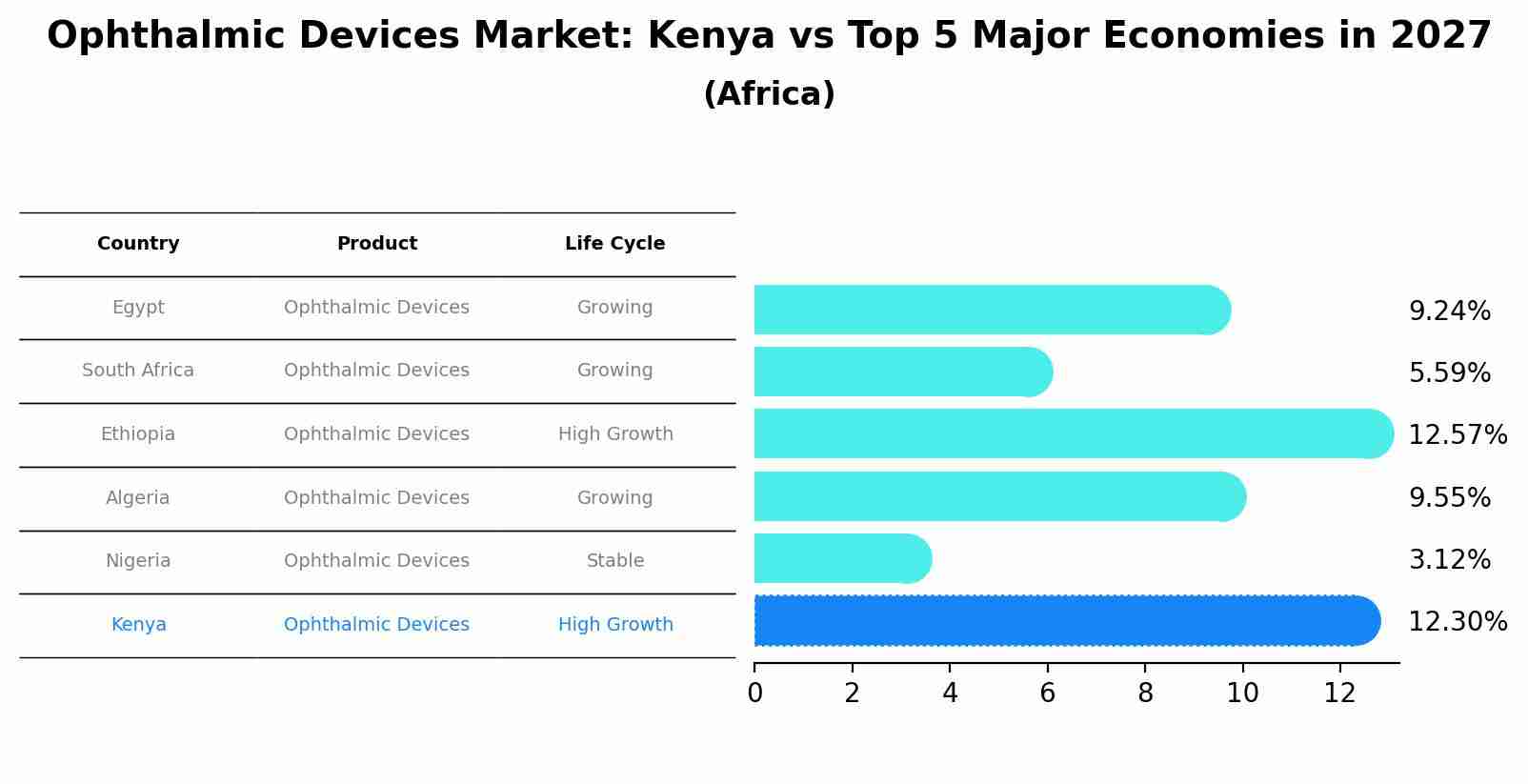Kenya Ophthalmic Devices Market Outlook | Companies, Growth, COVID-19 IMPACT, Value, Trends, Size, Analysis, Share, Forecast, Revenue & Industry
| Product Code: ETC367910 | Publication Date: Aug 2022 | Updated Date: Jul 2025 | Product Type: Market Research Report | |
| Publisher: 6Wresearch | Author: Sachin Kumar Rai | No. of Pages: 75 | No. of Figures: 35 | No. of Tables: 20 |
Kenya Ophthalmic Devices Market Size Growth Rate
The Kenya Ophthalmic Devices Market is projected to witness mixed growth rate patterns during 2025 to 2029. Growth accelerates to 12.30% in 2027, following an initial rate of 10.66%, before easing to 8.48% at the end of the period.

Ophthalmic Devices Market: Kenya vs Top 5 Major Economies in 2027 (Africa)
The Ophthalmic Devices market in Kenya is projected to grow at a high growth rate of 12.30% by 2027, within the Africa region led by Egypt, along with other countries like South Africa, Ethiopia, Algeria and Nigeria, collectively shaping a dynamic and evolving market environment driven by innovation and increasing adoption of emerging technologies.

Kenya Ophthalmic Devices Market Synopsis
The Kenya Ophthalmic Devices Market is experiencing steady growth driven by an increasing prevalence of eye disorders and a growing elderly population. The market is characterized by a diverse range of devices such as diagnostic and monitoring equipment, surgical instruments, and vision care products. Key factors influencing market growth include improved healthcare infrastructure, rising awareness about eye health, and advancements in technology. Major players in the market are focusing on product innovation, strategic partnerships, and mergers to gain a competitive edge. However, challenges such as limited access to eye care services in rural areas and affordability issues for certain segments of the population remain. Overall, the Kenya Ophthalmic Devices Market presents opportunities for expansion and development in the coming years.
Kenya Ophthalmic Devices Market Trends
Currently, the Kenya Ophthalmic Devices Market is witnessing several key trends. One prominent trend is the increasing adoption of advanced diagnostic and surgical technologies in ophthalmology. This includes the growing use of devices like optical coherence tomography (OCT) scanners, phacoemulsification systems for cataract surgery, and femtosecond lasers for precise corneal procedures. Another trend is the rising prevalence of eye diseases and vision impairments, driving the demand for ophthalmic devices for both diagnosis and treatment. Additionally, there is a growing focus on teleophthalmology and remote monitoring solutions to improve access to eye care services in remote areas. Overall, the market is experiencing a shift towards innovative technologies and solutions aimed at improving patient outcomes and enhancing the efficiency of eye care services in Kenya.
Kenya Ophthalmic Devices Market Challenges
In the Kenya Ophthalmic Devices Market, several challenges are prevalent, including limited access to eye care services in rural areas, shortage of skilled ophthalmologists and optometrists, inadequate infrastructure and equipment, and affordability issues for many patients. The lack of awareness about eye health and the importance of regular eye examinations also contributes to the challenges faced in the market. Additionally, regulatory hurdles, such as product registration requirements, can pose obstacles for companies looking to enter the market or introduce new ophthalmic devices. Overcoming these challenges will require collaborations between the government, healthcare providers, manufacturers, and other stakeholders to improve access to eye care services, enhance training programs for eye care professionals, invest in infrastructure development, and implement public awareness campaigns to promote eye health across the country.
Kenya Ophthalmic Devices Market Investment Opportunities
The Kenya ophthalmic devices market presents promising investment opportunities due to the increasing prevalence of eye diseases and the growing demand for advanced eye care solutions in the country. Key areas of investment include diagnostic devices such as optical coherence tomography (OCT) systems and fundus cameras, surgical instruments like phacoemulsification systems and intraocular lenses, as well as vision care products such as contact lenses and spectacles. With a rising middle-class population and improving healthcare infrastructure, there is a growing market potential for ophthalmic devices in Kenya. Investors can benefit from partnering with local distributors, healthcare providers, and government agencies to capitalize on the expanding market for eye care products and services in the region.
Jordan Agar Market Government Policies
The Kenyan government has implemented various policies related to the ophthalmic devices market to ensure quality and affordability. The Ministry of Health regulates the registration and importation of medical devices, including ophthalmic instruments, to guarantee their safety and effectiveness in line with international standards. Additionally, the government has established tax incentives and exemptions to encourage local manufacturing and reduce the cost of ophthalmic devices. Public-private partnerships are encouraged to enhance access to eye care services and promote the adoption of advanced technologies. Overall, these policies aim to improve the availability and accessibility of ophthalmic devices in Kenya, ultimately supporting the country`s vision health sector.
Kenya Ophthalmic Devices Market Future Outlook
The Kenya Ophthalmic Devices Market is poised for significant growth in the coming years, driven by factors such as an increasing prevalence of eye disorders, a growing elderly population, and rising awareness about eye health. Technological advancements in ophthalmic devices, such as advanced diagnostic tools and minimally invasive surgical equipment, are also expected to drive market expansion. Furthermore, the government`s efforts to improve healthcare infrastructure and increase access to eye care services in rural areas will further boost market growth. However, challenges such as limited healthcare funding, inadequate skilled professionals, and lack of awareness about eye diseases among the population may hinder the market`s growth to some extent. Overall, the Kenya Ophthalmic Devices Market shows promising prospects for growth and innovation in the near future.
Key Highlights of the Report:
- Kenya Ophthalmic Devices Market Outlook
- Market Size of Kenya Ophthalmic Devices Market, 2021
- Forecast of Kenya Ophthalmic Devices Market, 2031
- Historical Data and Forecast of Kenya Ophthalmic Devices Revenues & Volume for the Period 2018 - 2031
- Kenya Ophthalmic Devices Market Trend Evolution
- Kenya Ophthalmic Devices Market Drivers and Challenges
- Kenya Ophthalmic Devices Price Trends
- Kenya Ophthalmic Devices Porter's Five Forces
- Kenya Ophthalmic Devices Industry Life Cycle
- Historical Data and Forecast of Kenya Ophthalmic Devices Market Revenues & Volume By Product for the Period 2018 - 2031
- Historical Data and Forecast of Kenya Ophthalmic Devices Market Revenues & Volume By Optical Coherence Tomography Scanners for the Period 2018 - 2031
- Historical Data and Forecast of Kenya Ophthalmic Devices Market Revenues & Volume By Fundus Cameras for the Period 2018 - 2031
- Historical Data and Forecast of Kenya Ophthalmic Devices Market Revenues & Volume By Perimeters/Visual Field Analyzers for the Period 2018 - 2031
- Historical Data and Forecast of Kenya Ophthalmic Devices Market Revenues & Volume By Autorefractors and Keratometers for the Period 2018 - 2031
- Historical Data and Forecast of Kenya Ophthalmic Devices Market Revenues & Volume By Ophthalmic Ultrasound Imaging Systems for the Period 2018 - 2031
- Historical Data and Forecast of Kenya Ophthalmic Devices Market Revenues & Volume By Ophthalmic Pachymeters for the Period 2018 - 2031
- Historical Data and Forecast of Kenya Ophthalmic Devices Market Revenues & Volume By Tonometers for the Period 2018 - 2031
- Historical Data and Forecast of Kenya Optical Coherence Tomography Scanners Ophthalmic Devices Market Revenues & Volume By Slit Lamps for the Period 2018 - 2031
- Historical Data and Forecast of Kenya Ophthalmic Devices Market Revenues & Volume By Application for the Period 2018 - 2031
- Historical Data and Forecast of Kenya Ophthalmic Devices Market Revenues & Volume By Cataract for the Period 2018 - 2031
- Historical Data and Forecast of Kenya Ophthalmic Devices Market Revenues & Volume By Vitreo retinal disorders for the Period 2018 - 2031
- Historical Data and Forecast of Kenya Ophthalmic Devices Market Revenues & Volume By Glaucoma for the Period 2018 - 2031
- Historical Data and Forecast of Kenya Ophthalmic Devices Market Revenues & Volume By Refractor Disorders for the Period 2018 - 2031
- Historical Data and Forecast of Kenya Ophthalmic Devices Market Revenues & Volume By End-use for the Period 2018 - 2031
- Historical Data and Forecast of Kenya Ophthalmic Devices Market Revenues & Volume By Hospitals and Eye Clinics for the Period 2018 - 2031
- Historical Data and Forecast of Kenya Ophthalmic Devices Market Revenues & Volume By Academic and Research Laboratory for the Period 2018 - 2031
- Historical Data and Forecast of Kenya Ophthalmic Devices Market Revenues & Volume By Others for the Period 2018 - 2031
- Kenya Ophthalmic Devices Import Export Trade Statistics
- Market Opportunity Assessment By Product
- Market Opportunity Assessment By Application
- Market Opportunity Assessment By End-use
- Kenya Ophthalmic Devices Top Companies Market Share
- Kenya Ophthalmic Devices Competitive Benchmarking By Technical and Operational Parameters
- Kenya Ophthalmic Devices Company Profiles
- Kenya Ophthalmic Devices Key Strategic Recommendations
Frequently Asked Questions About the Market Study (FAQs):
- Single User License$ 1,995
- Department License$ 2,400
- Site License$ 3,120
- Global License$ 3,795
Search
Thought Leadership and Analyst Meet
Our Clients
Related Reports
- Canada Oil and Gas Market (2026-2032) | Share, Segmentation, Value, Industry, Trends, Forecast, Analysis, Size & Revenue, Growth, Competitive Landscape, Outlook, Companies
- Germany Breakfast Food Market (2026-2032) | Industry, Share, Growth, Size, Companies, Value, Analysis, Revenue, Trends, Forecast & Outlook
- Australia Briquette Market (2025-2031) | Growth, Size, Revenue, Forecast, Analysis, Trends, Value, Share, Industry & Companies
- Vietnam System Integrator Market (2025-2031) | Size, Companies, Analysis, Industry, Value, Forecast, Growth, Trends, Revenue & Share
- ASEAN and Thailand Brain Health Supplements Market (2025-2031) | Strategy, Consumer Insights, Analysis, Investment Trends, Opportunities, Growth, Size, Share, Industry, Revenue, Segments, Value, Segmentation, Supply, Forecast, Restraints, Outlook, Competition, Drivers, Trends, Demand, Pricing Analysis, Competitive, Strategic Insights, Companies, Challenges
- ASEAN Bearings Market (2025-2031) | Strategy, Consumer Insights, Analysis, Investment Trends, Opportunities, Growth, Size, Share, Industry, Revenue, Segments, Value, Segmentation, Supply, Forecast, Restraints, Outlook, Competition, Drivers, Trends, Demand, Pricing Analysis, Competitive, Strategic Insights, Companies, Challenges
- Europe Flooring Market (2025-2031) | Outlook, Share, Industry, Trends, Forecast, Companies, Revenue, Size, Analysis, Growth & Value
- Saudi Arabia Manlift Market (2025-2031) | Outlook, Size, Growth, Trends, Companies, Industry, Revenue, Value, Share, Forecast & Analysis
- Uganda Excavator, Crane, and Wheel Loaders Market (2025-2031) | Strategy, Consumer Insights, Analysis, Investment Trends, Opportunities, Growth, Size, Share, Industry, Revenue, Segments, Value, Segmentation, Supply, Forecast, Restraints, Outlook, Competition, Drivers, Trends, Demand, Pricing Analysis, Competitive, Strategic Insights, Companies, Challenges
- Rwanda Excavator, Crane, and Wheel Loaders Market (2025-2031) | Strategy, Consumer Insights, Analysis, Investment Trends, Opportunities, Growth, Size, Share, Industry, Revenue, Segments, Value, Segmentation, Supply, Forecast, Restraints, Outlook, Competition, Drivers, Trends, Demand, Pricing Analysis, Competitive, Strategic Insights, Companies, Challenges
Industry Events and Analyst Meet
Whitepaper
- Middle East & Africa Commercial Security Market Click here to view more.
- Middle East & Africa Fire Safety Systems & Equipment Market Click here to view more.
- GCC Drone Market Click here to view more.
- Middle East Lighting Fixture Market Click here to view more.
- GCC Physical & Perimeter Security Market Click here to view more.
6WResearch In News
- Doha a strategic location for EV manufacturing hub: IPA Qatar
- Demand for luxury TVs surging in the GCC, says Samsung
- Empowering Growth: The Thriving Journey of Bangladesh’s Cable Industry
- Demand for luxury TVs surging in the GCC, says Samsung
- Video call with a traditional healer? Once unthinkable, it’s now common in South Africa
- Intelligent Buildings To Smooth GCC’s Path To Net Zero


















